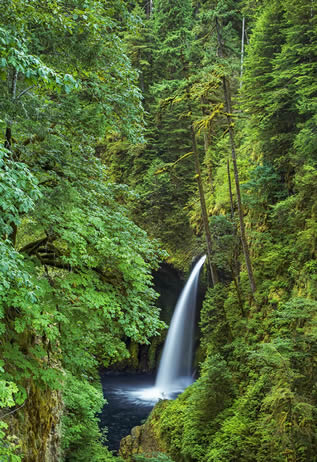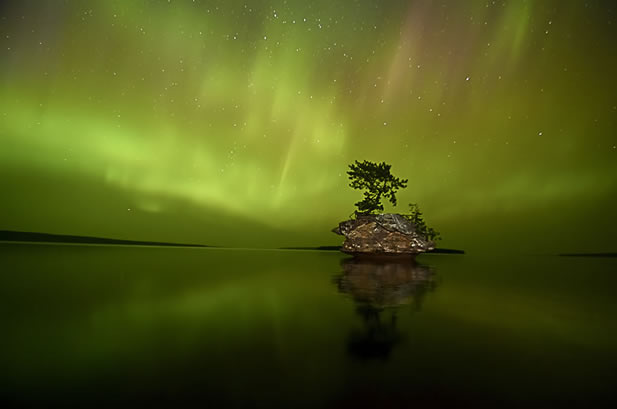It all began, in a way, with a photograph. In the summer of 1859, Charles L. Weed captured the first images of Yosemite Valley using the then cutting-edge technology of photography. His glass-plate negatives and stereographs were copied to engravings and printed in Hutching’s California Magazine, which was distributed throughout the United States, helping to make famous the wonders of the great valley. After Weed came Carleton Watkins, whose dramatic photographs of the Sierra Nevada’s granite peaks and huge trees were hung briefly outside the chamber of the US Senate, and which proved instrumental in the passage of the bill that created the world’s first nature preserve.
 © Thomas Goebel /NPB/ WildernessMetlako Falls, Mark O. Hatfield Wilderness, Oregon
© Thomas Goebel /NPB/ WildernessMetlako Falls, Mark O. Hatfield Wilderness, Oregon
Ever since, technical advancements and aesthetic refinements in landscape photography have closely tracked the evolution of the conservation ideal – Ansel Adams’s heroic compositions and Elliot Porter’s full color scenes running parallel to political achievements like the creation of the National Park Service, the passage of the Wilderness Act, the mid-twentieth-century push for new parks and monuments. It’s no exaggeration to say that the preservation impulse would not have had the same cultural force without photos to illustrate the point.
Yet landscape photography is tricky aesthetic terrain. The sublime is nothing if not squirrely, and there’s a thin line between true artistry and anodyne snapshots best suited for the walls of a dentist’s office. As many critics have pointed out, landscape photography, even of Ansel Adams’s caliber, can elide as much as it reveals. A frame inevitably simplifies a place, reducing the complexity of ecosystems and history into the flatness of mere scenery, and in the process creating a false impression of what wild nature is really like.
The apparent ease of landscape photography is also a virtue, however, since it makes the craft seem accessible to anyone with a camera. Given just the right moment, even an amateur has a shot at a masterpiece.
Recognizing that landscape photography is a genre made for crowdsourcing, the folks at Nature’s Best Photography teamed up with the Smithsonian Institution to sponsor a national contest of wilderness pictures in celebration of the Wilderness Act’s fiftieth anniversary.
Some of the “Wilderness Forever” contest winners and finalists (whose photos illustrate this edition of the Journal) are pros who have had their work published widely. Many are amateurs or novices. The image on the cover of this magazine, for example, was taken by a student photographer.
Such stunning images prove that awe-inspiring landscape photography is as much about heart as it is about eye. Landscape photography rewards patience, intrepidness, and fortitude – the same qualities required of anyone determined to connect with the spirit of the wild.
Winning photos from the “Wilderness Forever” contest will be exhibited this fall at the Smithsonian Institution’s National Museum of Natural History. To view the winning photos, visit www.naturesbestphotography.com
 © Verdon Tomajko /NPB/ WildernessMountain Goat Kids, Oreamnos americanus Mount Evans Wilderness, Colorado
© Verdon Tomajko /NPB/ WildernessMountain Goat Kids, Oreamnos americanus Mount Evans Wilderness, Colorado
 © Bobby Wheat /NPB/ WildernessRacetrack Playa at Sunset, Death Valley Wilderness, Nevada
© Bobby Wheat /NPB/ WildernessRacetrack Playa at Sunset, Death Valley Wilderness, Nevada
 © Jeff Rennicke /NPB/ WildernessAurora Borealis over Honeymoon Rock Apostle Islands National Lakeshore, Gaylord Nelson Wilderness, Wisconsin
© Jeff Rennicke /NPB/ WildernessAurora Borealis over Honeymoon Rock Apostle Islands National Lakeshore, Gaylord Nelson Wilderness, Wisconsin







Click or tap any of these images to see a slideshow of some of Nature’s Best Photography’s winning photos
We don’t have a paywall because, as a nonprofit publication, our mission is to inform, educate and inspire action to protect our living world. Which is why we rely on readers like you for support. If you believe in the work we do, please consider making a tax-deductible year-end donation to our Green Journalism Fund.
DonateGet four issues of the magazine at the discounted rate of $20.